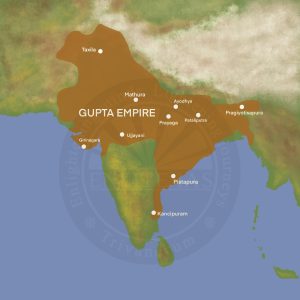Gupta Rule: Polity, Economy and Society
Administration
- The Council of Ministers aided the King.
- Uparika and Vishayapati led administrative units named Bhukti (province) and Vishaya (provincial division), respectively.
- Vishaya was further divided into Vithi, with the village being the smallest subdivision.
- The bureaucracy was not as extensive as that of Maurya.
Economy and Trade
- Issued a large number of gold coins called dinars.
- Agriculture, trade, business, and arts and crafts thrived under the Guptas.
- The King’s government assisted irrigation, measured land, and classified it as cultivated (Kshetra) or uncultivated (Khila/ Aprahata).
- Landowners (mahattars, Gramika, and Kutumbika) gained influence since it was a valuable asset to sell or give away.
- Craftsmen created both utilitarian and luxury objects; specific craftsmanship constituted the foundation for ‘jaati’-formation, i.e. caste.
- Shreni continued to manage the trader’s affairs.
- Common folks traded cowrie shells.
- Issued fewer pure gold coins than the Kushanas.
Social developments
- Brahmana supremacy continued (Narada smriti – a law book)
- Increase in the number of castes due to the absorption of many tribal people into the Brahmanical society.
- Position of Sudras improved – they could now listen to Ramayana, Mahabharata and Puranas, and were allowed to perform rites, contributing to a change in their economic status.
- Untouchables increased in number – Chandala account of traveller Fa-Hein.
- Polygamy existed among males due to excessive wealth.
- The Sati system appeared during the Gupta period. However, widow remarriage was allowed during the later Gupta period.
- Lower caste women enjoyed freedom for jobs which was lacking in higher caste women.
Religion
- Bhagavatism and Vaishnavism overshadowed Buddhism
- Idol worship was present.
- Buddhism was not prominent (some stupas and viharas existed)
- Nalanda came as a centre of Buddhist education (Kumaragupta/ Shakraditya)
- Jainism flourished in northern Bengal, Gorakhpur, and Udayagiri. Several Jain establishments existed across the empire and Jain councils were a regular occurrence.

